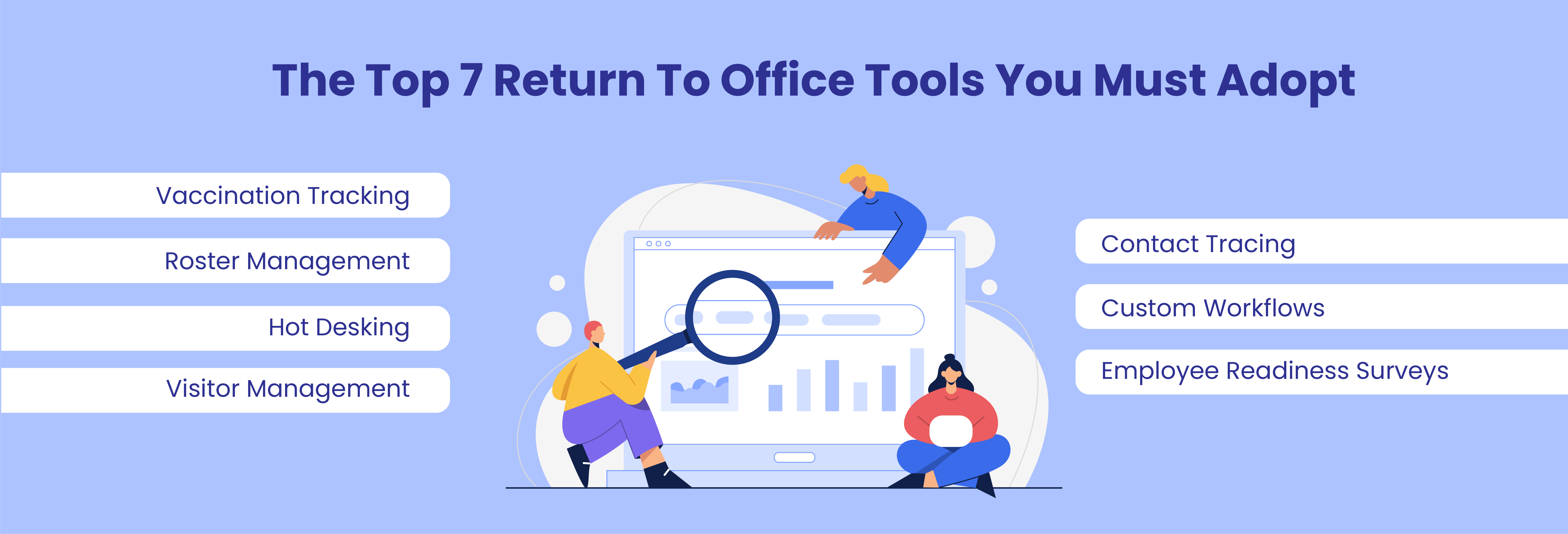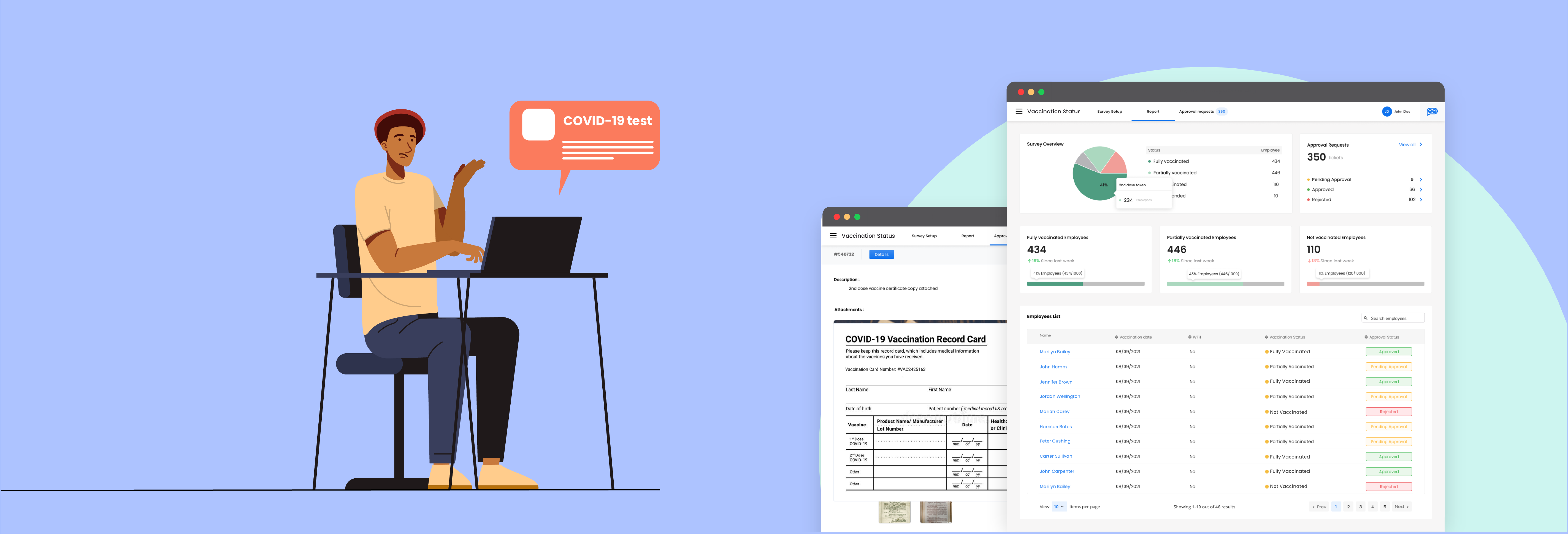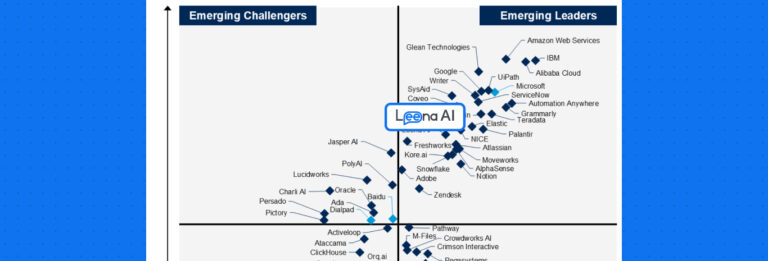We’ve survived our way through almost two years of remote operations and virtual meetings. But with vaccinations speeding up, organizations across the world are building a return to workplace plan for their employees. In fact, out of 350 CEOs, human resources, and finance leaders, 70% are planning to have employees return to the workplace by the fall of 2022.
Returning to the office is going to be a huge adjustment. But technology will play a critical role in ensuring employee safety at the workplace while also boosting the engagement at work.
However, with numerous workplace safety tools available, including the right ones in your technology stack can be a daunting task. That’s why we’ve come up with a list of 7 tools to make your return to workplace plan smart and seamless.
Top 7 Return to Workplace Tools

1. Roster Management
Roster management, also known as schedule management, is a process of creating and managing a list of employees and their information, such as location, timing, and responsibilities for a specific period. It is usually done in organizations with various shifts, such as morning and night shifts. The goal here is to ensure that each shift has an adequate number of employees so that productivity isn’t affected.
However, creating a staff roster can be a tricky process. Ensuring the right employees are assigned to the right task and shift can be daunting, especially while considering the employee’s health and safety and their availability at the given time. Hence, it’s best to make your rostering process as robust as possible with a rostering management tool.
A roster management software can help in scheduling staff, anywhere, anytime, to ensure your workers are in the right shift at the right time. This way, you can spend less time managing your employees and instead focus on what’s essential for growing your company. Further, it avoids overstaffing and notifies you about the risk of overtime pay or when you have exceeded the payroll budget.
Here’s how it works:
- HR professionals can easily create daily, weekly or fortnightly schedules according to departments, roles, and costs.
- Employees can track and view their schedules on any device. Plus, they can log in to the rostering software and set their availability to work.
- Managers can track hours worked for payroll accuracy and get insights into employee productivity.
- Ensure the payroll module complies with the business policies.
2. Hot Desking
As more organizations are adopting a hybrid workplace model, hot desking is becoming a new way to return to the office. This model allows employees to reserve a desk in advance for a particular day instead of providing them with a dedicated space or permanent office desk. In other words, desks are used by different workers at different times on an ad hoc basis. Employees can also select desks based on the co-workers they’re currently working on projects with.
To implement this system successfully in your company, desk booking software can be your best bet. It allows your employees to book their desks in advance for a period anywhere — in a quiet corner or among the bustling co-workers. Plus, it tells them where their team members are seated so they can sit near them for easier collaboration.
For example, suppose you’re planning to visit the office for focused work. But, the only desks available are in the noisiest part of your workplace. With a desk booking app, you can easily book a workspace according to your needs and customize your on-site experiences.
This system takes away the employees’ stress of finding a suitable desk. It also provides real-time space utilization data that helps limit the number of employees in the office and keep the infection rates under control.
Below are some common features you can find such tools:
- On-spot and advance desk bookings
- Locate desks close to employees’ teammates for flexible working
- Filter seats by employee teams or types of seating as available at your office
- Mobile and web-friendly experience.

3. Vaccination Tracking
With the availability of COVID-19 vaccines, organizations worldwide are required to create vaccine policies to mitigate the risk of infection and inquire about the vaccine status of every employee returning to the workplace. However, the main challenge lies in implementing a process to track and collect information about the current vaccination status of the workers.
Manually tracking can be time-consuming and error-prone as it requires storing data in hard copy files. Further, it can be challenging to ensure compliance with business vaccination mandates as regulations may change with time, and it won’t be easy to update employee status accordingly.
Enter: Vaccination tracking software.
A vaccine tracking tool enables companies to track the status of employee vaccinations in the office, including the proof of vaccination (photo), date of vaccination, and which employees do not meet vaccination requirements.
Some of its features are:
- Track vaccination proof and COVID-19 test results
- Provide employees with self-service options allowing them to update their vaccination status themselves
- Track COVID-19 symptoms
- Run detailed vaccination reports to ensure business compliance
- Web and mobile-friendly experience
- Schedule weekly COVID-19 test reminders and track workforce results
- Receive notifications for incomplete documents
- Track COVID-19 paid leaves
- Manage other HR tasks in one place, such as onboarding, compensation, payroll, etc.
- Create a COVID-19 tracking form with customizable fields, eSignature, and more
- Integrate with other relevant HR tools, like wellness survey systems.
Further, there are numerous factors you need to consider before selecting a vaccination management software, such as the number of employees in the company, your monthly or yearly budget, the type of features you need, kind of integrations, and so on.
4. Visitor Management
As offices are reopening, it’s not just your employees who will be coming back. Visitors, like your clients, customers, vendors, and job candidates, will also start dropping in as well. So, it’s critical to have a robust visitor management system for the positive experience of your visitors and your employees.
Visitor management is the process of keeping a check on the entry and exit of the guests in your office. However, it involves not only collecting their contact information but also the usage of the building and its facilities.
It offers the following benefits:
- Like a gatekeeper keeps the unwanted visitors at bay, a visitor management tool ensures that only approved visitors come inside.
- Typically placed in the reception, it also helps you control occupancy density in your workplace using computer vision or IR-based sensors.
- If there’s any case of COVID-19 within your office, having a digital log of guests can be used for easy contact tracing. This way, managers can inform and seclude the potentially infected workers to prevent further spread.
- A technology-enabled visitor management system securely manages and stores all visitor information and legal documentation they need to sign before entering your office, such as NDAs, contracts, etc.
- It makes the check-in process easier for visitors. You don’t have to worry about having someone always present at the reception to greet your guests, especially when you operate in a hybrid model. They can access their guest information with a single button click instead of going through multiple paper logbooks.
Such tools can give you insights into the type of guests entering your workplace, when they come, and how long they stay.
5. Contact Tracing
With COVID-19 infections soaring in certain areas, organizations must consider contact tracing to prevent workplace transmission of diseases and keep customers and employees safe. Contact tracing is a crucial infection control strategy that involves working with a person who has been diagnosed with COVID-19 to identify and support those who came in contact with the patient and have been infected.
The most basic form of contact tracing is recording the person’s name, phone number, and the time they entered the office. However, tracking them manually using spreadsheets can be daunting, especially for large organizations where verifying a vast employee database can be cumbersome. This is where a contact tracing tool comes into play.
A contact tracing software:
- Helps managers identify on-site workers and visitors who might have contacted an affected employee.
- Informs at-risk employees and visitors that they might have been exposed and should quarantine or take a COVID-19 test.
- Secures employees’ information as highly sensitive data is collected throughout the contact tracing process
- Mark cases as confidential for users who need complete privacy
- Alerts the employers when an employee comes to your entrance with COVID-related symptoms
- Monitors the hotspots of activity so you can sterilize the areas with maximum risk
- Keeps employees updated on any incidents in the organization.
6. Custom Workflows
Workflow automation helps businesses save time, money, and effort by automating manual tasks using advanced technology, AI (artificial intelligence), and machine learning. These tasks include sending follow-up emails, updating projects to workers, creating reminders, and more.
The goal is to speed up the repetitive work so you can focus on other essential aspects for growing your business. Not only does it boost productivity and improve employee work experience, but it also minimizes the chances of errors.
Here’s how workplace automation software can help:
- Inputs employee information into official HR systems, such as payroll, insurance policies, etc
- Shares information between team members with ease
- Ensures compliance with business policies
- Streamlines crucial HR processes like recruiting, onboarding, and offboarding to make them faster and more efficient
- Eliminates the need to remind team members about the tasks that need to be done
- Avoid confusion by conveying to employees their exact roles and tasks they are responsible for.
However, whatever workflow automation you choose, ensure it comes with features that allow both in-office and remote workers to collaborate in real-time. Plus, they should have access to the same information, allowing them to work cohesively.
7. Employee Readiness Surveys
Planning your return to the office program can be a complicated process. From safety protocols to whether workers are ready to come to the office as they used to pre-pandemic — there’s a lot to consider.
So, as you begin to create an effective return to the physical workplace plan, it’s crucial to understand how your employees feel about the transition. And the most effective way to ask their opinions is by conducting your employee readiness survey.
These surveys help evaluate the willingness of your workforce to return to the office by asking them to complete a survey. Plus, their answers can enable you to understand the areas where your employees have concerns and decide what you can do to address their problems.
Sending surveys to every employee via mail and manually analyzing the results can be tedious. But, with an employee survey platform, you can collect, measure, and act on real-time employee feedback and opinions. Plus, you can send surveys via outreach notifications and view and edit the survey questions to suit your needs.
Read through our step-by-step guide to building a return to office plan and learn about the right tools and techniques to adopt for high-yielding results.
Leena AI’s Covid Response Suite: A One-Stop Shop for all your return to workplace requirements

If you’re looking for HR software with 90% of the above tools rolled in one, then Leena AI’s COVID-19 response suite can be the right solution. It helps successfully implement a return to the office plan by managing workplace safety and employee health.
Some of its features include:
- Tracking and maintaining employee vaccination status and test results for a safe work environment
- Scheduling weekly reminders for the unvaccinated and partially vaccinated workers to submit their vaccination status and negative test results
- Screening employees’ health regularly to track their health and taking appropriate measures to protect other workers.
- Creating a roster of employees based on their vaccination status and health declarations
- Setting up custom workflows as and when needed.
Bottom line
As an HR manager, you’re not just responsible for personnel management and workplace maintenance. You also need to ensure the safety and productivity of employees in the post-pandemic work setup.
The seven workplace safety tools mentioned above are common to all businesses for maintaining an effective workspace. But, you might require more software depending on your business needs, office space, and employees. In a nutshell, whatever tools you choose, make sure they help deliver the best experience for both the employee and the organization as a whole.
Ready to take the first step? Get the COVID-19 workplace response suite today.






